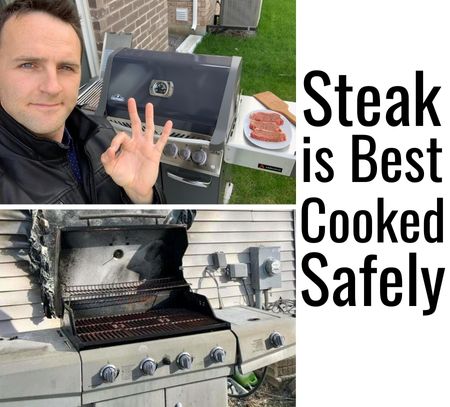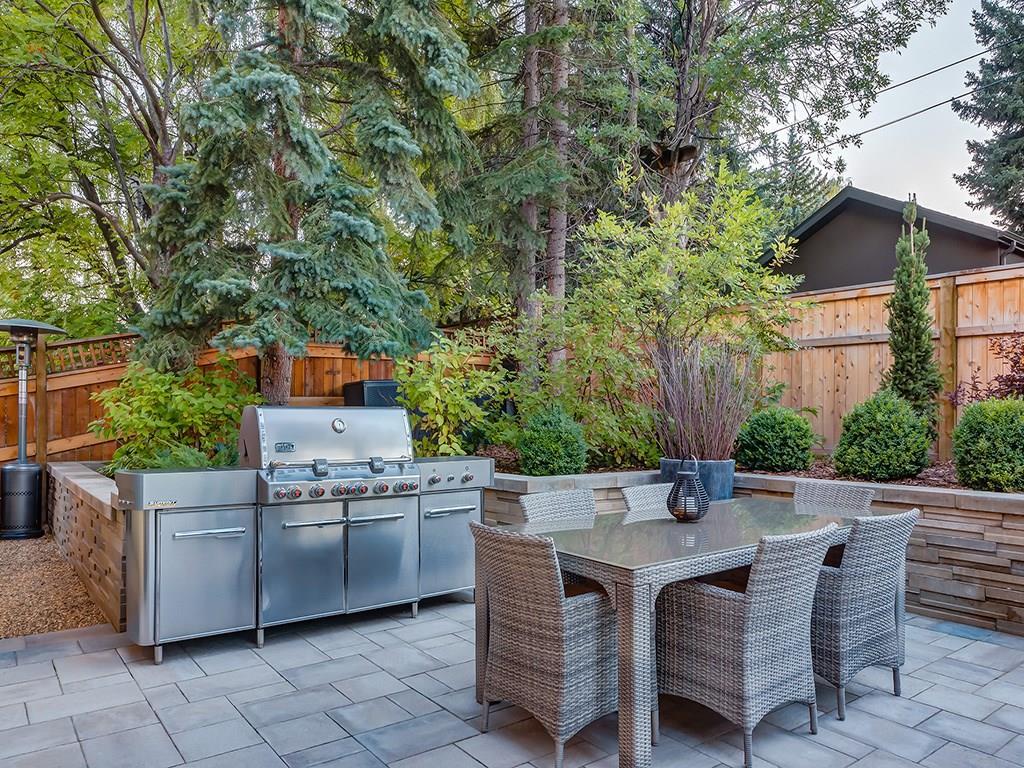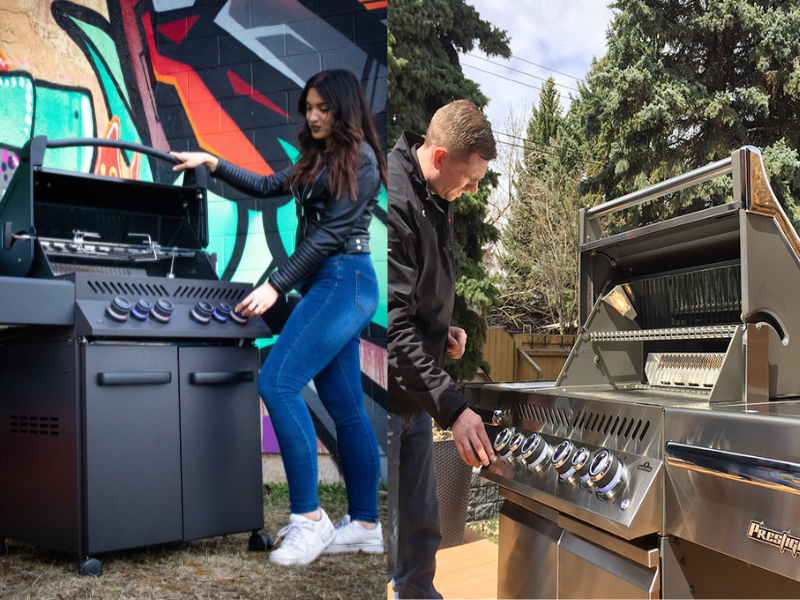No, this article was not artificially created. Why would we do that when we are the Barbecue experts? We thought we’d use a cute acronym to bring our expert barbecue advice to help you navigate through choosing your next barbecue based on which cooking fuel matters most to you; Charcoal, Gas, Pellets, & T. What’s T, you ask … TEMPERATURE, which is the most critical factor to getting the best flavour and the perfect cook every time regardless of which fuel you use.
To barbecue is to cook outside on an open flame, and barbecues can be fueled in multiple ways, so let’s take a closer look to compare your options.
Charcoal
Let’s start with the origin of barbecuing itself. Now, while wood-burning barbecues still exist, charcoal is far more common due to offering the most traditional method for infusing great flavours into meats of all kinds.
Charcoal, chunk or briquette barbecues, come in a variety of styles. The most recognizable being the Kettle barbecue, pioneered by Weber in the 1950s. The kettle features all of the things that define, not just charcoal barbecuing, but good barbecue in general; adjustable air shutters for temperature control, high heat capabilities, and relatively easy cleanup and maintenance.
Understanding charcoal fuel consumption is quite simple, the hotter you burn – the faster your charcoal or briquettes will run out. On most charcoal grills, you can adjust the air intake during each cook to adjust the temperature. Fuel consumption also depends on what you’re burning (hardwood lump charcoal, uniform-sized briquettes, etc.).
The next popular charcoal smoker is the Kamado-style grill. A kamado is a ceramic cooker (unless we’re talking about the double-walled steel body of the Broil King Keg 5000), directly inspired by the most ancient of outdoor cooking methods. Kamado manufacturers such as Big Green Egg and Kamado Joe feature heavyweight ceramics that insulate incredibly well, offer easy maintenance, and a cooking experience unlike anything else. The versatility and flexibility of the kamado means one can do everything from searing to smoking to baking.
Kamado-style grills are perfect for anyone passionate about barbecue, admires the finer details and doesn’t mind being attentive to their barbecue while it’s cooking over long periods of time.
Speaking of long periods of time, another popular style of charcoal barbecue is the vertical smoker, which is exclusively a smoker. Examples include the Broil King Vertical Smoker and the Yoder Stockton Vertical Smoker. These usually cannot reach hot searing temperatures but are designed to maintain that perfect low-and-slow temperatures needed to infuse your food with a generous amount of smoky flavour. Well-designed vertical smokers feature a water tray to keep the food moist, and a separate entryway to add more charcoal as needed. Remember, if you’re lookin’, then you're not cookin’ – so keep that lid closed. Let the thermometer tell your smartphone when the food is at the right temperature and is ready to be removed for a good resting period before serving.
Lighting a charcoal barbecue can take a bit of getting used to and it won’t heat up quite as quickly as a gas or pellet grill. There are different ways to ignite charcoal, all effective but with varying degrees of effort and lengths of time to achieve cooking temperature. We recommend using the Big Boy Smokestack Charcoal Chimney and rather than squirting a bunch of lighter fluid that may change the taste, try some simple Big Boy Fire-Starter Squares to kick-start every cook.
Gas: (Propane or Natural Gas)
Let’s review the Gas grill, the most common backyard barbecue in Canada today. A gas grill uses a fuel source that is combustible gas, such as liquid propane or natural gas. Who are these barbecues perfect for? People who demand convenience and need to cook and serve something quickly often prefer a gas grill that is easy to use and simple to maintain. Gas grills are manufactured with amazingly convenient features and come in a wide range of sizes, including outdoor kitchen islands to really ‘Wow’ your guests. In other words, gas barbecues are perfect for those who aspire to cook and entertain family and friends outside.
Gas grills come in many styles: freestanding, portable, and built-in islands (which offer the most customization options to help personalize your backyard grilling experience). Even the most seasoned pitmasters can benefit from having a gas grill because of its functionality as few outdoor cookers will be capable of heating up as fast as a gas one.
In Canada, many homes have a natural gas connection and many people would agree that it’s cheaper and more convenient to run natural gas than using propane tanks. Propane is still a great portable option, and a benefit of propane tends to burn hotter. Don’t worry if you are deciding between the two gas types, astute barbecue enthusiasts will note that the BTU(/hr) rating of a barbecue from any quality manufacturer these days will be the same across the two gases.
What does this really mean? It really comes down to if you have a natural gas connection or not, and if you don’t mind refilling a propane tank regularly. With a propane barbecue, you’re also able to move the barbecue anywhere you want. We bring this up because a natural gas barbecue is permanently affixed to a house (or where the natural gas outlet is) by a hose. If one wanted to move their natural gas barbecue beyond the reach of its current hose, they would have to purchase a new hose or an extension.
Pellet Fuel
In addition to charcoal and gas, there is a third fuel source that deserves your consideration because it is taking the barbecue world by storm. The incredible ease of use and functionality have driven the popularity of pellet grills in the last of couple years. Did you know that the Traeger brand of pellet grills has over 1.2 Million followers on Instagram? They’re often known as a ‘set it and forget it’ type of grill. A pellet is compressed hardwood, think of a little one-inch wood sausage, that’s sort of what a pellet is like. They are loaded into a hopper, usually on the side of the grill so they can be easily reloaded mid-cook if need be.
If you really want to take your pellet grilling and smoking game to a level that will make your neighbours beyond jealous, then check out the Yoder Smoker lineup. Go ahead and lift up that 10-gauge steel lid one time, and you instantly understand how their quality craftsmanship will last for decades.
Who are pellet grills excellent for? Those who want wood-smoked flavour without any of the perceived hassles of charcoal. Simply, power-on the grill (they run off electricity), load in your preferred flavour of pellets, and set the temperature, either on the grill itself or from your smartphone, then place the food on the grill once it’s up to temperature. Some units include food probes, where the grill can let you know exactly when the food has reached a specific temperature. All of these features come together for a complete package that is incredibly user-friendly.
Are there any drawbacks to a pellet grill? Getting in there and cleaning the ash out frequently (say every 2-3 cooks) is key to maintaining the longevity of a pellet machine.
Pellet grills are great for smoking and things that require relative heat like baking and roasting, but is it going to be able to sear a steak? Yes, all you need is the right accessory, like the Yoder Smokers A90468 Direct Grill Grates for YS480s & YS640s to help get your steak a similar grill lines finish as with a gas grill.
Temperature
Now let’s not forget, that a good temperature gauge is essential for every Barbecue enthusiast from beginner to expert. Every Chef in a restaurant kitchen uses a temperature gauge to be 100% sure the quality of their finished work is worthy of their guest's enjoyment, so why risk serving your family and friends anything less? Enjoy your outdoor cooking experiences, remember using a thermometer is about food safety, it will help you avoid undercooked chicken memories. Don’t guess – Cooking Time is only one factor – Use the Thermometer. Check Out our BLOG on Demystifying BBQ Thermometers to help guide you to the right one.
In Conclusion
Choosing a barbecue comes down to what you want to cook, how frequently you plan to use it, what type of flavours you want to infuse, and often what kind of fuel source you prefer.
At Barbecues Galore, we carry top brands in all three fuel categories. Reading is fun, but we encourage you to come into one of our five stores across Canada, where our barbecue experts are also in abundance and are happy to answer every question you have. Click here to find the store nearest to you.


















